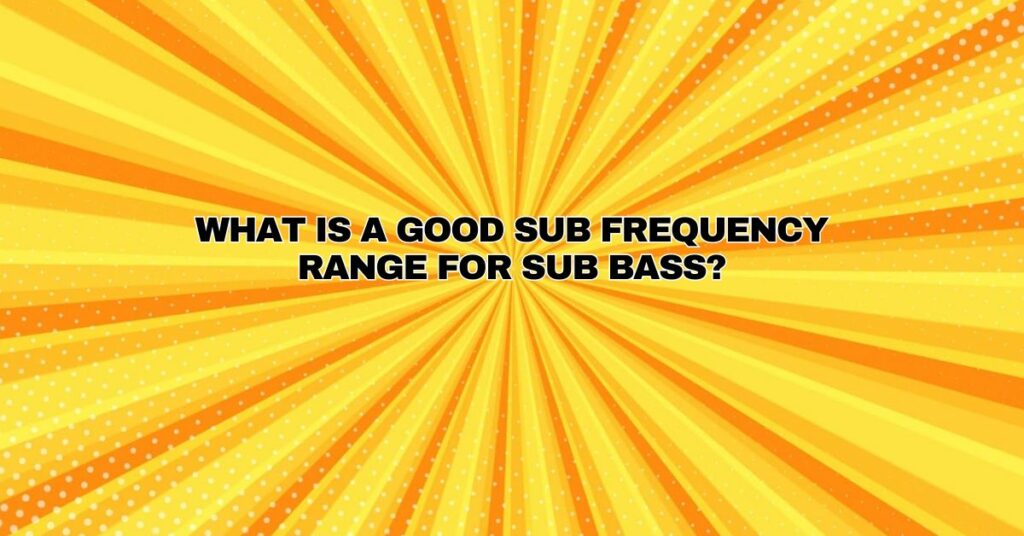In the world of music and audio production, the quest for the ideal sub frequency range for sub bass is an endeavor that captivates both seasoned professionals and budding enthusiasts. Sub bass, the fundamental underpinning of a track’s low end, is critical for shaping the sonic character and emotional impact of a piece of music. In this comprehensive article, we will embark on a journey to uncover the intricacies of the sub frequency range for sub bass, exploring the range itself, the factors that influence it, and the art of finding the perfect balance for a mesmerizing auditory experience.
Understanding Sub Bass
Sub bass is the realm of audio frequencies that exists at the deepest, lowest end of the audible spectrum. These frequencies are responsible for the resonant, powerful, and often visceral sensations that are felt as much as they are heard. Sub bass frequencies are generally categorized as those below 60 Hertz (Hz) and encompass the sub-bass, super sub-bass, and deep sub-bass segments.
- Sub-Bass (20-60 Hz): This is where the sub frequency range begins, providing the deep and foundational components of sound. Sub-bass frequencies, which typically start at 20 Hz, are known for their ability to create a profound sense of immersion and power.
- Super Sub-Bass (Below 20 Hz): Frequencies below 20 Hz are often referred to as super sub-bass or infrasound. While they may not be heard, they can still be felt and can significantly enhance the physical impact of audio, especially when using high-quality subwoofers and sound systems.
- Deep Sub-Bass (Below 10 Hz): Frequencies that delve below 10 Hz are classified as deep sub-bass. These are situated at the extreme low end of the audio spectrum, creating sensations that are more akin to tactile vibrations than audible sounds.
The Importance of the Ideal Sub Frequency Range
The sub frequency range for sub bass is crucial for several reasons:
- Emotional Impact: Sub bass frequencies have the power to evoke strong emotions and enhance the mood of a musical piece. The deep, resonant tones often carry an emotional weight that can be used to create a sense of grandeur, drama, suspense, or even tranquility.
- Immersive Soundscapes: In the context of audio production for film, video games, and immersive experiences, the sub frequency range plays a crucial role in building immersive soundscapes that transport the listener to different worlds. The depth it provides adds realism and emotional depth.
- Rhythm and Groove: Sub bass frequencies are vital for genres that rely on rhythm and groove, such as electronic dance music (EDM), hip-hop, and dubstep. The pulsating, energetic qualities of sub bass provide the essential groove that gets people moving.
- Balance and Fullness: In all forms of music, the sub frequency range contributes to a sense of balance and fullness. A well-defined sub bass range complements other musical elements, creating a cohesive and satisfying listening experience.
Factors Influencing the Ideal Sub Frequency Range
The choice of the ideal sub frequency range for sub bass is influenced by several factors:
- Genre and Style: Different musical genres and styles require different sub bass profiles. For instance, EDM often focuses on frequencies in the 30-60 Hz range to create a pulsating and energetic bassline, while ambient music may use lower frequencies to establish a deep, contemplative mood.
- Listening Environment: The ideal sub frequency range can vary based on the listening environment. In a nightclub or live concert setting, lower sub bass frequencies might be preferred to create a physical impact. In contrast, a home studio setup may benefit from a tighter, less room-dependent sub bass, necessitating higher frequencies in the sub frequency range.
- Instrumentation: The instruments used in a musical composition also influence the choice of sub frequency range. Electronic synthesizers and bass-heavy instruments may be designed to produce sub bass frequencies at different ranges. Adjusting the sub frequency range to complement these instruments is essential for achieving a cohesive sound.
- Layering and Stacking: In modern music production, sub bass frequencies are often layered and stacked with other sounds. Achieving the perfect balance between these layers is crucial to avoid muddiness or clashes.
- Room Acoustics: The acoustics of your listening environment can significantly affect the perceived sub frequency range. Room modes, standing waves, and resonances can emphasize or attenuate specific frequencies. Proper room treatment and calibration can help mitigate these issues.
Techniques and Tools for Crafting the Ideal Sub Frequency Range
Achieving the perfect sub frequency range for sub bass requires the right tools and techniques:
- Spectrum Analyzer: Utilize a spectrum analyzer to visualize the frequency content of your sub bass. This tool provides a clear picture of which frequencies need attention.
- EQ Plugins: High-quality EQ plugins allow for precise control over sub bass frequencies. Parametric and graphic EQs are commonly used to shape the sub frequency range.
- Subtractive EQ: Start with subtractive EQ to clean up your sub bass track. Identify and reduce any unwanted frequencies, such as rumble or resonance, before boosting the desired frequencies.
- Dynamic Processing: Compressors, limiters, and multiband compressors can help control the dynamics of sub bass frequencies, ensuring a consistent and powerful low end.
- Layering and Side-Chain Compression: When layering sub bass with other sounds, employ side-chain compression to create space for the sub bass frequencies, ensuring that they remain prominent without clashing with other elements.
Conclusion
Crafting the ideal sub frequency range for sub bass is a multifaceted endeavor that demands a keen understanding of musical context, listening environments, and the specific requirements of the music or audio production at hand. The sub frequency range, spanning from sub-bass to super sub-bass and even deep sub-bass, offers a realm of creative potential and emotional impact. By mastering the art


